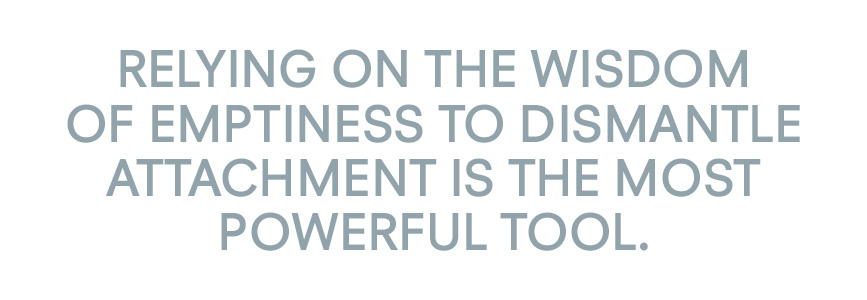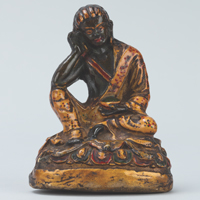
Harnessing the wisdom of emptiness to generate compassion
Khandro Kunga Bumma, known as Khandro-la affectionately by her followers around the world, left Tibet after having a series of visions to lead a spiritual life. Following her arrival in Nepal and with great hardship, including Khandro Kunga Bumma, known as Khandro-la affectionately by her followers around the world, left Tibet after having a series of visions to lead a spiritual life. Following her arrival in Nepal and with great hardship, including extreme health challenges, she went to India to meet with His Holiness the Dalai Lama. His Holiness recognized Khandro-la as a realized practitioner and the State Medium of the Tenma Oracle. He gave her the title Rangjung Neljorma, “Self-Arisen Dakini.”
Tenzin Gelek: How do you describe non-attachment?
Khandro-la: In Buddhist teaching, when we refer to attachment, we are talking about an affliction that obscures our mind. Our mind is obscured by ignorance, the misconception about how things exist and the belief that things exist independently without any causes and conditions. This wrong view propels attachment and other afflictions. We believe that attachment, by nature, is incidental, temporary, and interdependent. When we separate it from our mind with proper application of causes and conditions such as wisdom and methods, we can remove attachment from our mind, and we can achieve a state of non-attachment. Therefore, sometimes we use the term non-attachment as a means to describe our true nature of mind, which is devoid of attachment and other afflictions. Our true nature of mind is clear, illuminating, and empty.
Is compassion a form of attachment?
When we experience compassion, loving kindness, and bodhicitta, or awakening mind, we get attachment to sentient beings, such as to our family members. Although it is a form of attachment, there is a difference, depending how you feel the attachment and the causes for such an attachment. Attachment driven by compassion, love, and bodhicitta is not strictly affliction. This is because we can experience these feelings such as compassion without the self-grasping mind or seeing them as intrinsic.
Is non-attachment the same as detachment?
Non-attachment can be used to describe people who realize emptiness directly. When you look at the true nature of mind, it is free of attachment, so it can be both the state of non-attachment and detachment. But when we are in meditative equipoise, single pointedly placing our mind to an object, we do not experience the gross level of attachment. However, our mind is not totally free of attachment as we have not realized emptiness yet.
So to attain a non-attachment state you need to realize emptiness?
Yes. Only when we have realized emptiness are we in the state of non-attachment. In other words, when we have not realized emptiness, we are still under the influence of attachment, although sometimes the attachment is not active.
Is attachment a bad thing? What about being attached to loved ones?
There are different ways to practice our compassion to sentient beings. For example, when people show their compassion to someone who is lacking a means of living or survival, they do so by perceiving that the person exists intrinsically, that is independently without any causes and conditions. Likewise, their compassion, and the practitioner themself, all of these different parts are viewed as though everything has an intrinsic nature. This is what most of us do. This type of perception reinforces our confusion or ignorance and creates further afflictive emotions such as attachment and anger that produce pain.
We can view all sentient beings and their circumstances, our existence and practices, as a product of dependent origination and lacking intrinsic nature—everything we see as labeled by our mind or a projection of our mind. We come to understand that all of these phenomena are interdependent, yet they are fully functioning in conventional reality, so they experience favorable and non-favorable conditions through the workings of dependent origination. This type of view of compassion is proper and considered very powerful.
From this perspective, we see that although everything is lacking intrinsic nature, other sentient beings are still under the influence of the self-grasping mind and ignorance. They hold self as intrinsic, and through this misperception about self, they get attached to it and other things. This propels jealousy, harmful thoughts, perverted views, all sorts of suffering. This leads to conflict among family and nations.
With this understanding we feel compassion and love to sentient beings and wish them to be free of suffering. There is a sort of attachment here, but it is not propelled by ignorance. It is not an attachment that propels suffering. This can be a pure attachment, a sense of virtuous emotion, and it is not an attachment strictly defined in our ordinary sense.
We feel love for our family members, parents, and children. In an ordinary sense, it is a positive feeling. But it is still a form of attachment. These loves formed by seeing things as intrinsic nature become causes for sufferings later.
Can you share an example?
When a couple first gets married, their attachment to each other provides pleasure. However, this pleasure does not exist intrinsically and doesn’t last. When you are attached to a person, you don’t see the person is composed of flesh, bones, and other substances that are conditional and subject to decay. You don’t see the person is under the influence of afflictions such as attachment and anger.
When we get attached to such a person, we see the person as incredibly beautiful, the best, the most precious, and totally solid and permanent. However, when we observe carefully, in reality, we realize that they are constantly changing, subject to impermanence and the conditions and causes that produce suffering. We also realize that this attachment itself is a source of suffering for them and for us.
Our attachment to them provides benefit in the short term, physically and mentally. We later realize that our perception of them is incorrect, and we are holding the wrong view of the person. This is because we confuse the impermanent as the permanent, the nature of suffering as the happiness, the impure nature as the pure nature, selfless nature as self-nature.
Of course, we need a companion, income, a good reputation—there’s nothing wrong with that. However, we must realize that these are produced with causes and conditions, and they lack intrinsic nature.

How can we practice non-attachment to materials and people that are not healthy?
In order to confront this issue, we must realize that we are confused. So we should not look outside but look introspectively, inside our mind. We should examine the true nature of the object of our attachment, the true nature of our mind that gets attached to it. We need to examine what the mind looks like when we feel attached, how this mind grasps things, what is the aim or what does the mind want, what is the result of this attachment. First we ask these questions to ourselves. Then we can focus our examination to the object of our attachment by looking at how we perceive that object or person.
For example, when we don’t like someone, rather than trying to change the person, we need to look at our perception, observe and investigate how this dislike feeling is taking shape in our mind. We will realize that, in most cases, this disliking has more to do with ourselves, our ignorance or confused state of our mind, rather than how things exist out there. This method is a good approach for dealing with our attachment to the wrong things. If we don’t change our mind or attitude by looking introspectively, we can’t change our behavior.
Is practicing non-attachment a realistic goal?
Yes. When we talk about happiness and suffering, they are not permanent and intrinsic. They are interdependent and relative, so they can be changed and abandoned. Attachment is a form of an ignorant state of our mind; this ignorance is incidental and temporary but not the true nature of our mind. The true nature of our mind is pure, clear, bright, and empty. Attachment and other afflictions are circumstantial and incidental; they are formed through interdependent and relative conditions. To dismantle the attachment, we need to look at the reality of the attachment and how the attachment is formed. If we are able to understand that materials and people do not exist as we perceive them to, then our attachment will fall apart.
In order to dismantle suffering, we need to dismantle attachment. Therefore, relying on the wisdom of emptiness to dismantle attachment is the most powerful tool. Not only does it enable us to root out attachment but it also enables us to generate a powerful compassion and loving-kindness that we can extend to all beings. Through seeing the true nature of all things, seeing that everything is part of dependent origination, we are able to abandon our attachment to a select group of people. We see every being as the same in their basic nature and conditions, thus enabling us to see and extend our compassion and loving-kindness to all.
How can we practice non-attachment in daily life?
First we need to see the negative results of attachment. Then there are many approaches we can use to abandon attachment, including understanding the true nature of attachment—that everything lacks intrinsic nature and that attachment itself is impermanent and interdependent. Then there are practical means to reduce attachment, including being aware of thoughts that reinforce it.
How can we be goal oriented while practicing non-attachment?
When we think about our goals, we need to understand that we do not want suffering and our ultimate goal is happiness. Likewise, all other sentient beings wish for the same thing. So our intention or motivation should not be only focused on oneself but for all sentient beings, as we are all connected.
Since all phenomena are relative and dependent on each other, we know that they are not absolute and inherent. If we follow such a view, then practicing the Buddhist Dharma and doing business are not two separate things. The clearer we see the workings of interdependence and interconnection the less conflict we see between achieving goals and practicing non-attachment. When we are not attached and have a pure intention, it helps open our hearts to accomplish many things.
How does one handle the paradox of being attached to practicing non-attachment?
A temporary way of letting go of attachment is practicing a single-pointed concentration meditation technique. Although it pacifies our gross level of attachment in the short term, it does not totally abandon our attachment. When we come out of our meditation or yoga, the afflictions such as attachment and anger will appear again.
In order to abandon attachment effectively, we have to work with the root causes of attachment, which is getting rid of self-grasping and self-cherishing minds. If our practice does not deal with these two elements, our abandonment becomes shallow. You can press down the attachment, but it will appear again when opportunities arise.
Therefore, if we are getting attached to our non-attachment practice, we need to become familiar with the correct understanding of our mind and our attachments. Through continuous practices, we will be able to overcome any form of attachment.
How is non-attachment related to freedom and liberation or enlightenment?
Buddhists believe that knowing the true nature of the mind and becoming familiar with it will root out all sources of affliction including attachment. Once we attain this realization, our mind is free of all affliction, devoid of attachment, and embedded with all good qualities. This level where the true nature of our mind is realized is what we call Sanggye, or Enlightenment. It is a state of mind rather than a destination or a place.
What role does it play in identity formation?
When we say for example, “I am an American,” I am this and that, and so on, the very concept about “I” is a form of attachment. Here one is holding the concept about “I” as intrinsic and absolute. When our mind is bound by this concept of a concrete “I”, it becomes attachment, and it naturally becomes confused.
Whenever we see forms, hear sounds, taste things, and feel emotions, our attachment become activated. The attachment goes hand in hand with the grasping mind, with craving. So we are not saying that everything that we attach to is empty. Speaking relatively, we can enjoy good qualities and things. We should not say this is a form of attachment and we should abandon it. But we should not be attached to the concept of them existing intrinsically. Once we understand the true nature of how things exist, it opens our mind, enabling us to practice loving-kindness and compassion to all beings.
About the Contributors
Khandro-la teaches around the world and is a sought-after speaker for her wisdom and compassion. Her teachings focus on generating bodhicitta, the awakened mind, and the wisdom of emptiness. She also serves as an advisor to numerous Buddhist teachers and their Dharma centers globally.
Tenzin Gelek is senior specialist, Himalayan arts and culture, at the Rubin Museum of Art.





